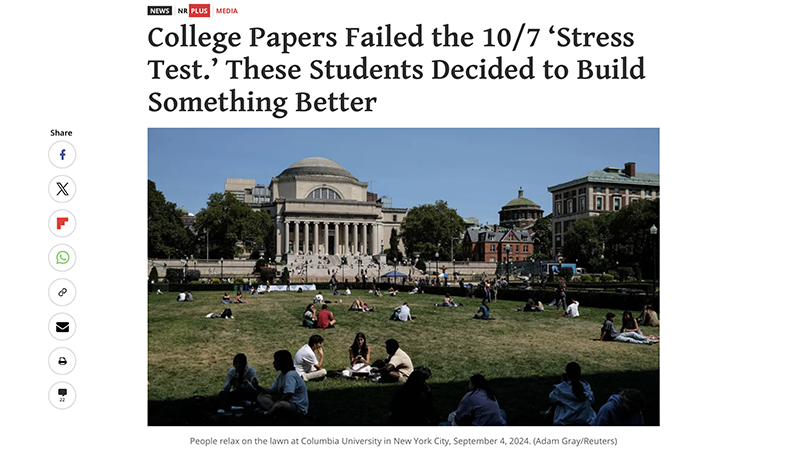
Below is an article by David Zimmermann, a news writer for National Review, that originally appeared in National Review Online. You can find the original article here.
As progressive hysteria overwhelmed American campuses in the wake of the Hamas terror attack on October 7 last year, a small group of independent-minded journalists across nearly two dozen elite universities used their unique access to expose the ideological rot that led their classmates to turn on Israel with such vitriol.
These reporters covered the anti-Israel campus protests and encampments for independent newspapers and magazines at Columbia University, New York University, and the University of Pennsylvania. Though most of the publications they wrote for predate 2023, a few, like the Columbia Sundial, were founded in the aftermath of October 7 in response to the wave of left-wing radicalism the attack exposed.
Founded by then-junior Jonas Du in January, the Sundial strives to promote viewpoint diversity on campus without succumbing to ideological conformity.
“The Sundial was started to fill a very large void on campus,” Du told National Review, “and that void was the fact that there wasn’t an institution that was facilitating campus discourse about important and controversial topics in a way that was engaging and effective.”
He went on to say how the student-run Columbia Daily Spectator has become more partisan and pro-censorship in its opinion section over time, creating a hole in the media market and allowing room for a heterodox publication.
A monthly magazine and Substack publication, the Sundial revives a school magazine of the same name, for which Barack Obama wrote an article in 1983 when he was an undergraduate at Columbia. Both iterations were named after the Ivy League university’s sundial landmark, which “has long served as a meeting point and place for discussion, debate, and protest,” Du wrote in March alongside fellow editors Nick Chimicles and Jackson Cheramie.
The Sundial’s coverage mostly consists of narrative journalism, commentary, and analysis rather than hard-hitting news, which is what the Spectator primarily focuses on. Du wanted to differentiate his own media venture from the main campus paper.
“Our focus is not to compete with the Spectator. They almost, given their storied history, have an obligation to cover every single newsworthy event on campus,” Du said. “We, on the other hand, as a magazine, have the freedom to pick and choose the stories we cover and to empower our writers to inject their own narratives and opinions into that.”
The Sundial’s Substack features numerous stories ranging from a print interview with longshot presidential candidate Cornel West during his April visit to Columbia to a news article about protesters sneaking onto campus through a gap in the school’s gates.
Though there was no immediate reporting about the April 30 Hamilton Hall occupation on the website, Du and his Sundial staff covered the barricades of the campus building and subsequent arrests of protesters extensively on X. Du later published an essay after the Manhattan district attorney’s office dropped trespassing charges against 31 of the 46 Columbia protesters who occupied Hamilton Hall.
Despite publishing critical content on anti-Israel protesters and their disdain for free speech, the Sundial has received positive feedback from faculty and even gained the respect of some people who may disagree with the writers’ views.
“If you present people with a well-reasoned argument, even if it’s something they disagree with, more often than not, people reading those are going to be pretty receptive of them,” Du said.
The Student Journalism Association (SJA), created by the Fund for American Studies (TFAS) last year, has and continues to support the Sundial and at least 18 other alternative publications through funding and training. Up to $15,000 per academic year is provided to each publication, with most of the funds depending on the newspaper staff’s quarterly performance. SJA staffers also frequently visit campuses to personally help up-and-coming journalists.
Ryan Wolfe, director of the Center for Excellence in Journalism at TFAS, told National Review that while SJA started in spring 2023, interest in the newly formed program from student journalists didn’t spike until after the Hamas-led attack last October.
“We got some bites, but the level of interest and the need for an alternative didn’t really become evident until after October 7,” he said.
Wolfe described the October 7 massacre as a “stress test” for mainstream campus newspapers that exposed antisemitism and a disdain for free speech among their editorial boards. Meanwhile, other newspapers stifled students’ opinions or did not cover the news accurately.
“I think what people ended up seeing from that stress test was the cost of starting something new might be worth it,” he said. “The current system might actually be that bad that we need an alternative.”
That was the driving force behind Kayla Hutt’s decision to co-found the NYU Review with fellow editor Adam Goldman last fall. A sophomore at the time, Hutt wanted to provide a platform for students who felt excluded from the mainstream campus publication’s one-sided coverage.
“Many Jewish and Israeli students expressed their discomfort writing for the paper either because they couldn’t write about specific Israel-related events or stories or simply because they felt unwelcome,” Hutt told National Review. “We wanted to create a space and a publication where everyone feels welcome and included, even those with differing perspectives, because we hold that journalism is meant to showcase different voices and encourage public discourse.”
The NYU Review covered the fallout from 10/7, recording the antisemitic climate that seized New York City. As demonstrations on both sides broke out on campus and in the city, the NYU Review was there to document them.
For instance, a peaceful anti-Israel protest at NYU was disrupted by a violent student who started causing a commotion before punching a cameraman twice and breaking his phone on the ground. Additionally, public-school students across the city staged a walkout to demand an immediate cease-fire in Gaza and called for an end to U.S. funding of Israel. The NYU Review reported that protesters vandalized a police car as bystanders walked by.
The online newspaper also covered an NYU professor who was suspended for recording himself saying the Israeli hostages abducted by Hamas “actually liked their time” in captivity, and that maybe he “would also enjoy it and have good food and meet some people.”
Meanwhile, a Jewish student was removed from his position in NYU student government after introducing a resolution to condemn the Hamas attack, call for the release of the Israeli hostages, and advocate for civil dialogue on campus. His resolution was struck down, and two weeks later, he was informed of the student government’s upcoming vote to remove him. The effort ultimately failed, and the student was reinstated by the administration shortly thereafter.
Hutt said because of the surge in antisemitism following October 7, Jewish students chose the NYU Review to write about the vitriol they faced from anti-Israel protesters.
“Jewish students are our most frequent staff writers because they have been excluded and isolated and genuinely need us as their outlet,” she said.
The Pennsylvania Post, described as the “independent voice” of Penn on its website, was also born out of the need for an alternative publication. Lexi Boccuzzi, alumni adviser and founding editor, started the Penn Post after she became frustrated with the Daily Pennsylvanian’s response to the October 7 protests on campus.
“The Daily Pennsylvanian’s coverage was incomplete and failed to provide the Penn community with all the information needed to understand the events on campus,” she told National Review. “When put to the test of a crisis, the Daily Pennsylvanian failed to remain committed to journalistic integrity.”
Contributing to the mainstream campus newspaper’s opinion column for nearly four years, Boccuzzi resigned because the editorial staff prioritized politics over free speech in its editing and publishing process.
While declining to publish Penn donor Marc Rowan’s letter for using “incendiary” language about antisemitism on campus, the Daily Pennsylvanian editors ran a letter from then-Board of Trustees chairman Scott Bok who defended himself and then-President Liz Magill from Rowan’s criticisms. Boccuzzi cited this double standard as one of the reasons for her resignation earlier this year.
“It often felt to me and others as though the Daily Pennsylvanian was conscious of their role in shaping the narrative at Penn, which felt wrong,” she said. “Gatekeeping or censoring ideas that may make editors uncomfortable risks deeply sheltering campus community members from vital information.”
“We knew that our role had to be to cover the protests in a more nuanced and honest perspective, which is why our writers and editors, including myself, were on the ground covering Penn’s encampments every night.”
The Penn Post prides itself on publishing various opinions that its competitor won’t, like the unfair advantages that transgender student-athletes possess in women’s sports or two opposing views of anti-Israel protests. While enforcing strict editorial standards, the paper remains dedicated to opposing censorship.
“A commitment to free speech like ours should not be novel but should really be a principle of every university journalistic publication,” Boccuzzi said. “Without a willingness to platform a host of competing ideas, a campus publication simply cannot be the type of platform for debate that is necessary to adequately represent both the breadth of ideas and the complexity of narratives that these issues require.”

